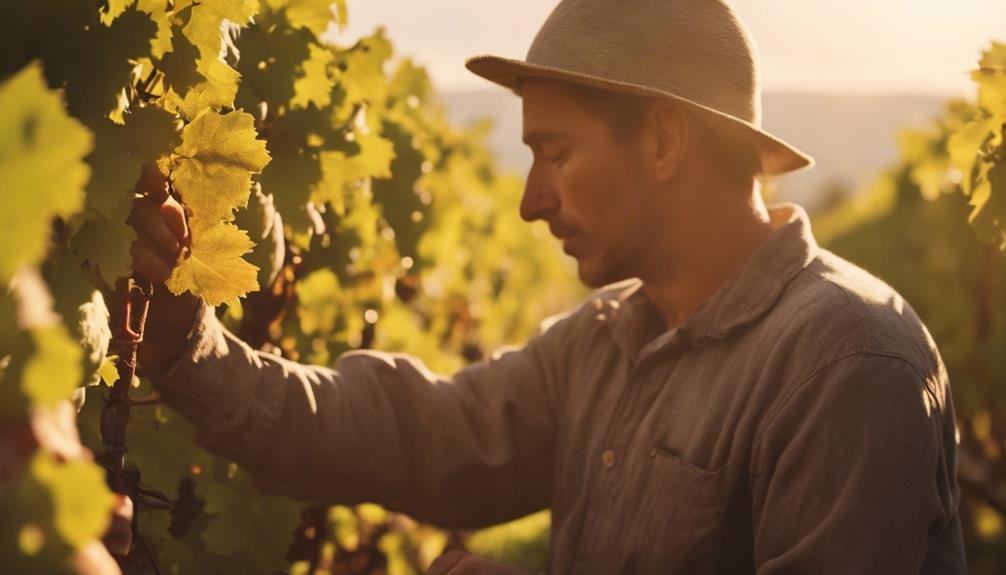Exploring grapevine growth uncovers the essential practices for thriving vineyards. Winter pruning and protecting spring buds are key for healthy growth. Different pruning techniques impact crop size and grape quality greatly. Training methods and proper vineyard care influence grape sustainability and vigor. Understanding the flowering process and optimizing harvest timing enhance overall grape quality. Monitoring grape ripeness, managing the canopy, and soil analysis are important steps for successful harvests. Delving into the secrets of grapevine growth reveals a world of techniques and stages important for producing high-quality grapes.
Grapevine Growth Cycles
Grapevine growth cycles intricately follow seasonal patterns, essential for the successful cultivation of quality grapes. Vineyard maintenance plays a pivotal role in ensuring ideal grapevine growth and development throughout the year. Seasonal vine care involves tasks such as winter pruning to encourage new growth, protecting delicate spring buds from potential damage like hailstorms, and implementing pruning strategies that influence crop size and grape concentration.
Understanding the lifecycle of a grapevine is vital for vineyard managers to make informed decisions regarding vine care practices. By adhering to proper seasonal vine care techniques, vineyard owners can help grapevines thrive and produce high-quality grapes that are essential for the production of premium wines.
Essential Grapevine Pruning Techniques
An integral component of vineyard maintenance practices involves implementing precise and strategic pruning techniques to optimize grapevine health and productivity. Pruning benefits vineyards by promoting better airflow and sunlight exposure, reducing disease risk, and enhancing grape quality. Various pruning techniques are utilized based on vineyard design and strategies to achieve specific goals. Below is a table outlining common pruning techniques and their impact on grapevines:
| Pruning Technique | Benefits |
|---|---|
| Spur Pruning | Encourages fruit production |
| Cane Pruning | Balances vine growth and yield |
| Crown Cleaning | Removes damaged or diseased wood |
| Green Pruning | Manages canopy density and vigor |
Impact of Training on Grape Quality

The training methods employed in vineyards play a vital role in enhancing the quality of grapes harvested for wine production.
Vineyard management practices, including sustainability practices, are essential factors influenced by training techniques. Proper training impacts soil health and irrigation techniques, ensuring the vines receive sufficient nutrients and water for excellent grape development.
By implementing efficient training systems, vine vigor is maintained, leading to improved grape quality. These methods not only enhance the current harvest but also contribute to the long-term sustainability of the vineyard.
Careful consideration of training practices is essential in ensuring grapevines reach their full potential, producing high-quality grapes essential for premium wine production.
Understanding Grapevine Flowering Process
With its intricate and delicate process, the flowering stage in the life cycle of a grapevine marks a pivotal shift towards grape development. During this stage, the vine's flowers undergo important development, leading to the pollination process essential for grape production.
The flower development is a key precursor to grape formation and influences the subsequent stages of growth. Factors such as vineyard biodiversity and climatic influences play a significant role in this process, affecting the timing and success of pollination.
Understanding the grapevine flowering process is essential for vineyard management, as it impacts the quality and quantity of the eventual grape harvest. By closely monitoring and nurturing this stage, vineyard owners can optimize conditions for successful pollination and ensure a bountiful grape yield.
Optimizing Harvest Timing and Quality

Efficiently managing grapevine growth to maximize harvest quality and timing is essential for vineyard success. Vineyard management plays a vital role in ensuring ideal fruit development and grape quality. To achieve this, vineyard owners and viticulturists should consider the following key points:
- Regular monitoring of grape ripeness levels to determine the ideal harvest time.
- Implementing canopy management techniques to improve sunlight exposure and airflow around grape clusters.
- Utilizing irrigation strategies to control water availability during critical fruit development stages.
- Conducting regular soil analysis to guarantee the vineyard provides the necessary nutrients for grape maturation.
Frequently Asked Questions
Can Grapevines Survive Extreme Weather Conditions?
Grapevines display remarkable climate adaptations and vineyard resilience to withstand extreme weather conditions. Understanding the effects of hailstorms, frost, and heatwaves on grapevine survival is vital for vineyard management. Implementing proper strategies guarantees the vines' endurance.
How Do Different Soil Types Affect Grapevine Growth?
Different soil types greatly influence grapevine growth. Soil composition has a profound impact on root development, affecting vine vigor and grape quality. Understanding how different soils interact with grapevines aids in optimizing cultivation practices for sustainable vineyard management.
What Are the Signs of Nutrient Deficiencies in Grapevines?
Identifying symptoms of nutrient deficiencies in grapevines is essential for vineyard health. Yellowing leaves, stunted growth, and poor fruit development are common signs. Treating deficiencies involves soil testing, targeted fertilization, and adjusting vineyard management practices to promote healthy grapevine growth.
Are There Natural Methods to Control Pests in Vineyards?
Organic solutions for vineyard pest control include integrated pest management practices that utilize beneficial insects and cover crops. These methods focus on minimizing chemical use, promoting biodiversity, and maintaining a balanced ecosystem to naturally deter pests.
How Does Altitude Impact Grapevine Development?
Altitude influences grapevine development by altering climatic conditions. High altitudes offer cooler temperatures, promoting extended ripening periods and enhancing grape flavor complexity. Low altitudes provide warmth, aiding in early maturity and sugar accumulation. These factors impact grapevine health and resilience.
Conclusion
To sum up, grasping the secrets of grapevine growth is crucial for cultivating high-quality grapes. One interesting statistic to note is that a well-pruned grapevine can produce up to 20 pounds of grapes per vine.
By mastering essential pruning techniques, optimizing training methods, and timing the harvest accurately, grape growers can maximize grape production and quality.
Delving into the intricate process of grapevine growth allows for a deeper appreciation of the art and science behind viticulture.